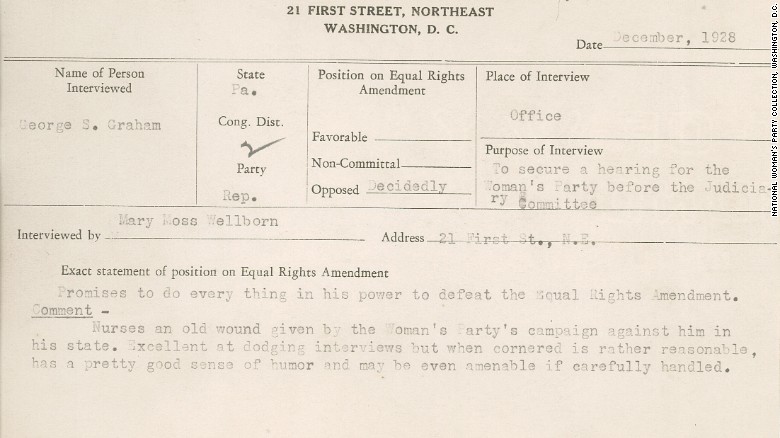(CNN)Friday marks the 45th anniversary of Women's Equality Day, designated in 1971 to commemorate the 1920 passage of the 19th Amendment, which gave women the right to vote.
But voting was only the beginning for some women's rights advocates, who pivoted in the 1920s to the larger issue of enshrining equal rights in the Constitution. Penned by Alice Paul, the Equal Rights Amendment was first introduced to Congress in 1923 by Rep. Daniel R. Anthony, nephew of women's suffrage leader Susan B. Anthony.
Anthony's 1923 proposal didn't pass. In fact, it was very polarizing, even among women. Eleanor Roosevelt, for instance, opposed the ERA for many years. One of the major objections at the time was questioning how the ERA would impact protective labor legislation, rules that guarded against issues like unfair hours or dangerous work conditions for women.
"If you have an amendment that says men and women are completely equal under the eyes of the law, what does that do to those protections that have then been instilled specifically based on gender?" Jennifer Krafchik, deputy director of the National Woman's Party, explained to CNN.
The ERA was introduced in the next 49 consecutive sessions of Congress until 1972, when it passed and was sent to the states for ratification. It fell three states short in 1982. It was most recently introduced to both chambers of Congress in May 2015.
The woman responsible for reintroducing the ERA to the House last year was New York Democratic Rep. Carolyn Maloney.
"Almost 100 years after women were granted the right to vote, it is past time to enshrine full equality for all in the Constitution and ratify the ERA," Maloney said in a written statement to CNN.
The history of the ERA is one of the major focal points at the newly minted Belmont-Paul Women's Equality National Monument. Formerly known as the Sewall-Belmont House and Museum, President Barack Obama designated the site earlier this year as part of an initiative to celebrate women's history at national park sites.
The National Park Service and National Woman's Party now partner to educate visitors from around the world on the history of women's rights in the United States.
Visitors are able to see items from the National Woman's Party collection, which holds thousands of items from their effort, including congressional voting cards, an ink-and-paper database detailing information on the congressmen and senators the NWP lobbied on issues like suffrage and the ERA.

The fight for the ERA today is very different than it was 90 years ago.
"The concerns that existed so many years ago are not as much of a concern today," Krafchik said. "However, there are some very hot-button issues that cause concern for opposition to the Equal Rights Amendment. One of those is abortion. One of those continues to be women in military service, although we are rapidly chipping away at that."
Another ongoing issue that has gained traction this election cycle is the pay gap.
Regardless of personal beliefs about the need for the ERA, the Belmont-Paul staff emphasizes education on the issue.
"Some people believe that women are already guaranteed equal rights in the Constitution, based on the 14th Amendment," Krafchik said, explaining a common misconception. "Whether you support the ERA or don't support the ERA, understanding where we've come from, where we still have to go and the rights that we're still fighting for is an important message for us."
- Publish my comments...
- 0 Comments
